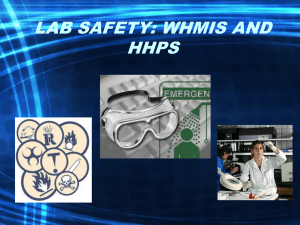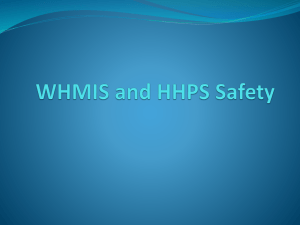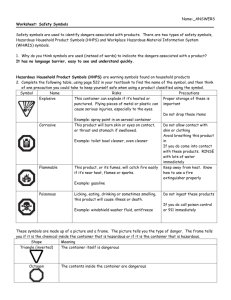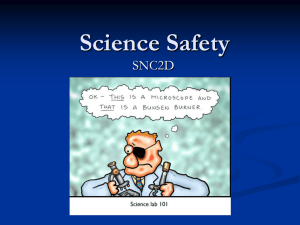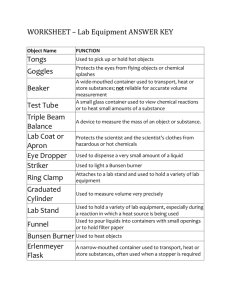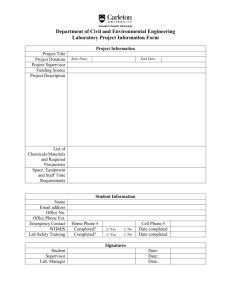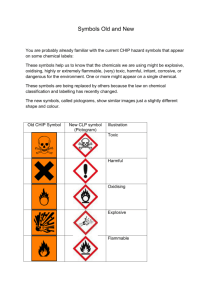File
advertisement
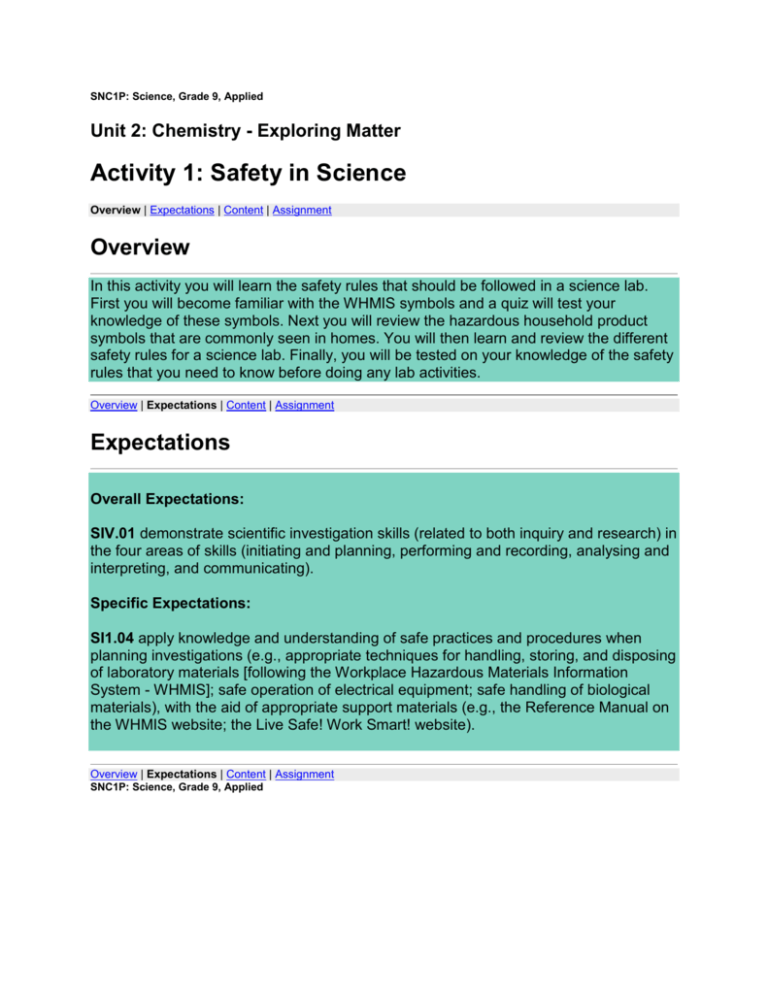
SNC1P: Science, Grade 9, Applied Unit 2: Chemistry - Exploring Matter Activity 1: Safety in Science Overview | Expectations | Content | Assignment Overview In this activity you will learn the safety rules that should be followed in a science lab. First you will become familiar with the WHMIS symbols and a quiz will test your knowledge of these symbols. Next you will review the hazardous household product symbols that are commonly seen in homes. You will then learn and review the different safety rules for a science lab. Finally, you will be tested on your knowledge of the safety rules that you need to know before doing any lab activities. Overview | Expectations | Content | Assignment Expectations Overall Expectations: SIV.01 demonstrate scientific investigation skills (related to both inquiry and research) in the four areas of skills (initiating and planning, performing and recording, analysing and interpreting, and communicating). Specific Expectations: SI1.04 apply knowledge and understanding of safe practices and procedures when planning investigations (e.g., appropriate techniques for handling, storing, and disposing of laboratory materials [following the Workplace Hazardous Materials Information System - WHMIS]; safe operation of electrical equipment; safe handling of biological materials), with the aid of appropriate support materials (e.g., the Reference Manual on the WHMIS website; the Live Safe! Work Smart! website). Overview | Expectations | Content | Assignment SNC1P: Science, Grade 9, Applied Content Safety Symbols It is important to have a complete understanding of safety symbols and rules before working with chemicals or equipment in a science classroom. This activity provides you with information on how to prevent an accident and what you should do if an accident does occur in the science lab. Refer to this activity before carrying out an investigation involving any hazards. WHMIS Symbols Canada's national hazard communication standard is called WHMIS (Workplace Hazardous Materials Information System). Materials are labelled according to the type of hazard they possess. The following are common symbols used by WHMIS. WHMIS symbol Risks Precautions heat may cause the container to explode drop or impact may cause the do not drop or heat handle with care store in a designated container to explode Compressed Gas area keep away from heat sources a potential fire hazard may release a flammable gas avoid sparks and on contact with water Flammable and Combustible Material flames store in cool, fireproof area combustible materials fire and explosive risk may burn skin or eyes on store in a designated area contact Oxidizing Material keep away from wear eye, face, and hand protection as well as protective clothing may be fatal or cause ventilated area permanent damage if inhaled, swallowed, or absorbed through skin Poisonous and Infectious Materials may burn skin or eyes on contact Poisonous and Infectious Material Causing Other Toxic Effects avoid contact with skin or eyes wear protective clothing contact by wearing result of repeated exposure protective equipment may cause irritation to eyes, ventilated area and may cause cancer wear respiratory may cause allergic reaction equipment avoid contamination of people and area some parasites shock cause lung damage if inhaled wear body, hand, face, and eye protection cause eye and skin irritation when subjected to heat, with water work in a wellventilated area undergo dangerous reactions pressure, shock, or contact avoid all direct body contact on contact Corrosive Material work and store in special areas can eat through skin or corrode metals avoid breathing vapours may cause anaphylactic work in a well- skin, and lungs bacteria, viruses, fungi, and Biohazardous Infectious Material avoid skin or eye permanent damage as a includes bacteria, toxins from wear respiratory equipment may cause death or work in a well- take care when handling avoid vibration and shocks Dangerously Reactive Material may burn unexpectedly do not change the temperature suddenly store in appropriate, sealed container View the long description of this table. WHMIS Symbols WHMIS symbol: Compressed Gas Risks: heat may cause the container to explode; drop or impact may cause the container to explode Precautions: do not drop or heat; handle with care; store in a designated area WHMIS symbol: Flammable and Combustible Material Risks: a potential fire hazard; may release a flammable gas on contact with water Precautions: keep away from heat sources; avoid sparks and flames; store in cool, fireproof area WHMIS symbol: Oxidizing Material Risks: fire and explosive risk; may burn skin or eyes on contact Precautions: keep away from combustible materials; store in a designated area; wear eye, face, and hand protection as well as protective clothing WHMIS symbol: Poisonous and Infectious Materials Risks: may be fatal or cause permanent damage if inhaled, swallowed, or absorbed through skin; may burn skin or eyes on contact Precautions: work in a well-ventilated area; wear respiratory equipment; avoid contact with skin or eyes; wear protective clothing WHMIS symbol: Poisonous and Infectious Material Causing Other Toxic Effects Risks: may cause death or permanent damage as a result of repeated exposure; may cause irritation to eyes, skin, and lungs; may cause cancer; may cause allergic reaction Precautions: avoid skin or eye contact by wearing protective equipment; work in a wellventilated area and wear respiratory equipment WHMIS symbol: Biohazardous Infectious Material Risks: includes bacteria, toxins from bacteria, viruses, fungi, and some parasites; may cause anaphylactic shock Precautions: avoid contamination of people and area; avoid breathing vapours; work and store in special areas WHMIS symbol: Corrosive Material Risks: can eat through skin or corrode metals; cause lung damage if inhaled; cause eye and skin irritation on contact Precautions: avoid all direct body contact; wear body, hand, face, and eye protection; work in a well-ventilated area WHMIS symbol: Dangerously Reactive Material Risks: undergo dangerous reactions when subjected to heat, pressure, shock, or contact with water; may burn unexpectedly Precautions: take care when handling; avoid vibration and shocks; do not change the temperature suddenly; store in appropriate, sealed container Hazardous Household Product Symbols (HHPS) These symbols are found on household products such as cleaners, paint thinners, sprays, and pesticides. The products can be potentially dangerous to humans and should be stored with care. The warning symbols have three different shapes to indicate the degree of danger. Caution HHPS Warning Danger Risks even a small amount may poison, cause injury, or death when swallowed, absorbed through the skin, or inhaled into the lungs examples include paint, pesticides, household cleaners Poison substances that can quickly ignite examples include gasoline, motor oil, barbecue starter Flammable can react with air, water, or another substance Explosive container will explode if heated or punctured examples include aerosol spray cans, barbecue propane tanks can burn skin or eyes examples include drain cleaners, battery acid, oven cleaners Corrosive View the long description of the table. HHPS Risks Poison even a small amount may poison, cause injury, or death when swallowed, absorbed through the skin, or inhaled into the lungs; examples include paint, pesticides, and household cleaners. Flammable substances that can quickly ignite; examples include gasoline, motor oil, and barbecue starters. Explosive can react with air, water, or another substance; container will explode if heated or punctured; examples include aerosol spray cans, barbecue propane tanks. Corrosive can burn skin or eyes; examples include drain cleaners, battery acid, and oven cleaners. Check Your Understanding Answer the following questions in your notebooks. Then check your answers when you are finished. 1. Draw the shape of the symbol with the highest risk. Answer 2. What does HHPS represent in words? Answer 3. What are the risks in using a barbecue lighter? Answer Content Safety Rules in the Science Classroom You should read over and become familiar with the following safety rules. General Safety Rules 1. Read over the lab activity carefully before you begin. 2. Keep a tidy work area free of extra books and papers. 3. Know the location of the following safety equipment: safety goggles, protective aprons, fire extinguisher, eyewash fountains, shower, and first aid kit. 4. Know the location of the nearest fire exit. 5. Follow the teacher's instructions when carrying out a lab activity. 6. Tie back loose hair and clothing. 7. Report to your teacher if you wear contact lenses or have any allergies. 8. Do not eat or drink anything in the laboratory. Do not chew gum during an activity. 9. Watch for sharp or jagged edges on all apparatus. Do not use broken or cracked glassware. Place broken glass and sharp objects into a specially marked container. 10. Wash your hands with soap and water after you handle chemicals, biological specimens, and microorganisms. 11. Clean and dry your work area after a lab activity. Do not leave water on the counter or floor. 12. Report all accidents to your teacher - no matter how small. Chemical Precautions Fire extinguishers are mounted on a wall in a classroom. 13. Do not taste, touch, or smell any material unless instructed to do so by your teacher. 14. Never smell a chemical directly. Bring the chemical close to the front of your body and a distance under your nose. Then wave the fumes toward your nose. 15. When instructed by the teacher, wear safety goggles throughout the lab activity. Wear other safety equipment such as aprons, gloves, and lab coats as required. 16. When pouring liquids hold the container away from your face. 17. Do not return unused chemicals to the original containers. Your teacher will instruct you what to do with unused chemicals. 18. Never pour harmful substances in the sink. Dispose of them as instructed by your teacher. 19. Report all spills to your teacher. Wipe up any splashes or spills of water immediately. 20. If any part of your body comes in contact with a harmful chemical quickly inform your teacher. Wash the area immediately and thoroughly with water. If your eyes are affected, wash them immediately and continuously for at least 15 minutes at the eyewash station. If a chemical splash is all over your clothes and body, wash them immediately and continuously for at least 15 minutes at the shower station. Check Your Understanding Complete the following questions in your notebook. Read over each of the safety rules below and write one good reason why we have this rule. Check your answers when you have completed all the questions. 1. Keep your safety goggles on as long as there are chemicals being used in the lab, even if you are finished. Answer 2. Never eat, drink, or chew gum during a lab activity. Answer 3. Report any injuries, no matter how minor, to your teacher. Answer 4. If a chemical gets splashed into your eyes, rinse it out at the eyewash station for at least 15 minutes. Answer Heating Precautions 1. Never use chipped or cracked glassware. Never allow a container to boil dry. 2. When heating a test tube containing a chemical, use a test tube holder and slant the test tube away from yourself and others. 3. Take caution when using hotplates. Hotplates can take up to 60 minutes to cool completely. Do not touch the hotplate when it is in use or when it is cooling. If you burn yourself, inform your teacher immediately and apply cold water or ice. Bunsen Burner Precautions 4. Obtain instructions from your teacher on the proper method of lighting and using a Bunsen burner. 5. Never heat a flammable substance over the Bunsen burner. 6. Be sure there are no flammable materials nearby before you light a Bunsen burner. 7. Never leave a lighted Bunsen burner unattended. 8. Always turn off the gas at the valve, not the base of the Bunsen burner. Electrical Precautions 9. Always unplug electric cords by pulling on the plug, not the cord. 10. Report any frayed cords or damaged outlets to your teacher. 11. Make sure your hands are dry when using electrical equipment Take a virtual tour of a science lab at a school. H:\20142015\SNC1P\1227420_SNC1P_Unit_2_En\SNC1PPU02\SNC1PPU02A01\mme\ safetyInTheVirtualLab\safetyInTheVirtualLab.htm Check Your Understanding Complete the following questions in your notebook. Check your answers when you are finished your work. 8. When you are heating a test tube containing a chemical, slant the test tube from you and classmates. Answer 9. Allow a hot plate to completely cool for minutes. Answer 10. Never pull an electrical cord by the . Answer 11. Never leave a(n) substance over or close to a Bunsen burner. Answer This is a disclaimer. External Resources will open in a new window. Not responsible for external content. Unless otherwise indicated, all images in this Activity are from the public domain or are © clipart.com or Microsoft clipart and are used with permission. Assignment Assignment 1 Quiz When you are ready ask your teacher for the Symbols quiz. Your teacher will provide you with instructions when s/he gives you your quiz. Assignment 2 Quiz When you are ready ask your teacher for the Safety quiz. Your teacher will provide you with instructions when s/he gives you your quiz. This is a disclaimer. Not responsible for external content. Unless otherwise indicated, all images in this Activity are from the public domain or are © clipart.com or Microsoft clipart and are used with permission. Overview | Expectations | Content | Assignment
